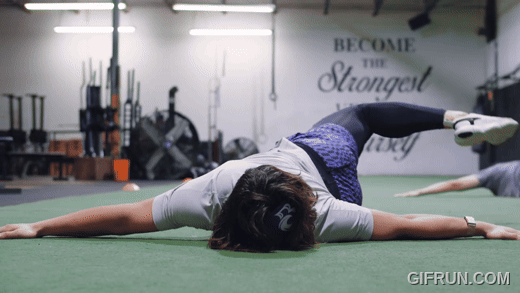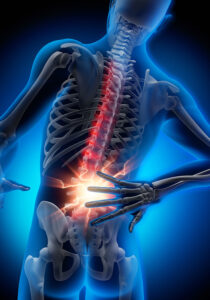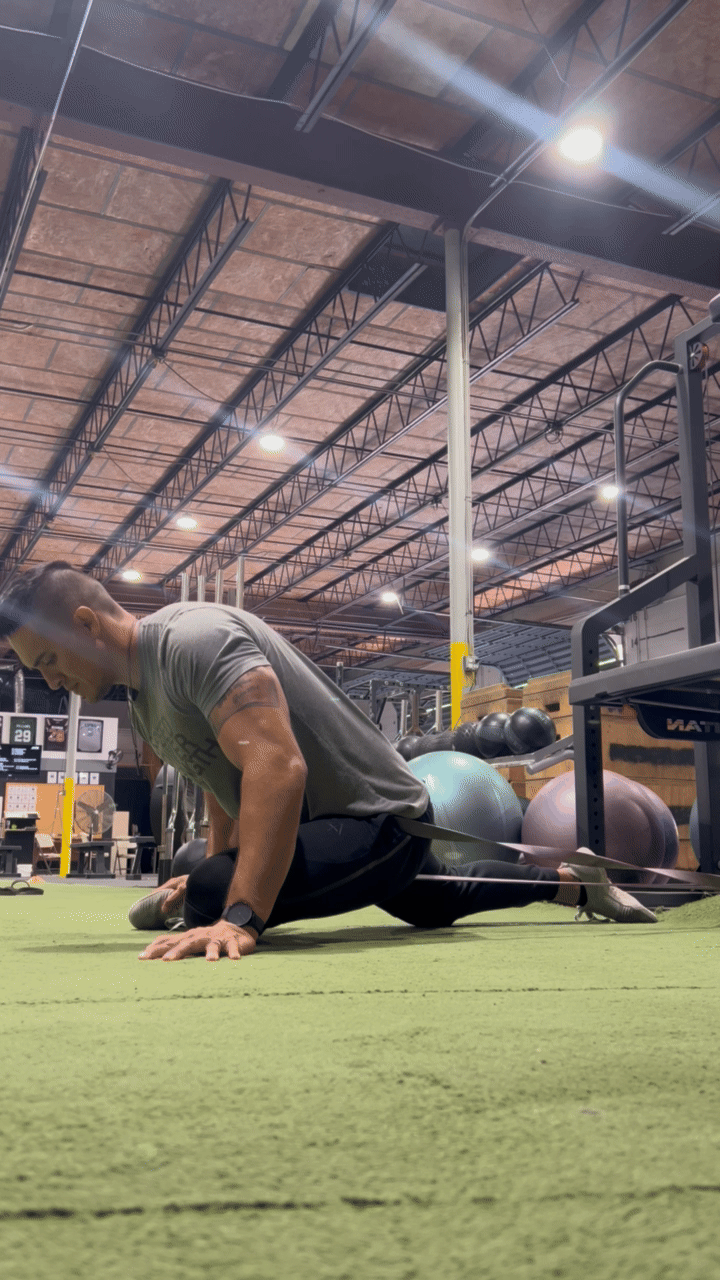Low Back Pain is Common
In my last season of semi pro football, I strained my hamstring during the preseason and never really addressed it. This led to a lower back issue and even though I was able to play through it, it still affected my performance the entire season and for more than a year afterward. For a while I had a hard time even deadlifting 135. After football was over, I spent a lot of time looking into how I could heal my low back issue. A few years later I was able to deadlift nearly 500 pounds with no back pain.
It’s very common for heavy lifters to experience pain with the amount of load they’re putting on their bodies. Fact of the matter is that it’s really unavoidable. If you are someone truly trying to push the limits of your physical performance, then there is an increased physical risk associated with that. Whether it’s for strength, speed, jumping, or throwing, the more you push yourself to reach another level, the more likely it is you are going to put strain on your body and risk injuries and pain.
Higher physical reward means there is higher physical risk.
Don’t Stop Training. Train Smarter.
Over my years coaching, I’ve worked with several athletes dealing with low back and hip issues. Not all necessarily from lifting either. Could be from pattern overload in their sport. Weakness from not doing any strength training. Asymmetries that need to be corrected. No matter what though, the athlete still needs to train.
Great athletes and performers learn how to modify and train around pain. If you are feeling pain in your back from doing a lift, that doesn’t mean to stop training altogether. You select a different lift. Work in the ranges where you don’t have pain. Or adjust your programming to work more on overall mobility.
Recently I attended a webinar on low back pain and function from Dr. Jordan Shallow. Very informative and really gave me more confirmation on the proper way to rehabilitate and address low back pain in athletes. Nowadays, there are so many “functional” coaches and physical therapists that have a very reductionist view of training. As in, “Oh, this movement hurts? Okay we’ll just never do it again.”
This view is wrong and just not helpful at all. It just creates a fear with training. Athletes need to be able to mitigate and address pains and of course correct movement as best they can, but that never means they stop training entirely.
Don’t Just Stretch. Strengthen!
The most common answer whenever an athlete feels back pain is to just go stretch. That is the lazy answer. Yes, it can be helpful for an athlete to stretch, but it isn’t the entire solution and also won’t help long term. It’s not just always a mobility issue. A lot of times it’s also a strength issue and the athlete needs to improve muscle tissue tolerance surrounding their low back.
Just stretching might make them feel good temporarily, but as soon as they apply heavy load to their spine again, that pain will come right back.
The other answer is doing the McGill Big 3: Side Plank, Bird Dog, and McGill Sit Up. Those are the most basic and fine for beginners. But for advanced high performing athletes and lifters, that’s not going to be good enough. Rehabilitating low back pain needs to be progress-able same as any strength training plan. Movements need to be progressively advanced and loaded to drive physical adaptation and help build a more durable lower back.
Joint By Joint Theory
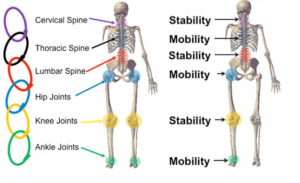 I learned about the Joint-by-Joint Theory in a course from Joe Defranco, which he shared from legendary strength coach Mike Boyle. This was basically a theory to help look at joint pain and dysfunction from a global perspective. The area of pain is usually not also the source of the pain. There is some dysfunction above or below that area that is leading directly to more stress there.
I learned about the Joint-by-Joint Theory in a course from Joe Defranco, which he shared from legendary strength coach Mike Boyle. This was basically a theory to help look at joint pain and dysfunction from a global perspective. The area of pain is usually not also the source of the pain. There is some dysfunction above or below that area that is leading directly to more stress there.
For example: if an athlete has really tight ankles and is back squatting, the lack of dorsiflexion forces other joints above to compensate. That dysfunction travels up the chain and will basically force more flexion in the hips in order to reach squat depth, which would place more direct stress on the spine.
So, I wanted to share a few drills that I most often use to address an athlete’s low back pain.
Here are my 5 favorite mobility and strength exercises to help:
Banded Pigeon Stretch
I’ll start off with a couple of stretches. I really love band assisted stretching to really help isolate and get a deeper stretch in specific areas. This is a progression on the basic pigeon hip stretch.
Using the band, you get a deeper and more intense stretch on the piriformis, which attaches from your lower spine to the upper thigh. Do this for 1 1/2 to 2 minutes each side.
Banded Hip Flexor Stretch
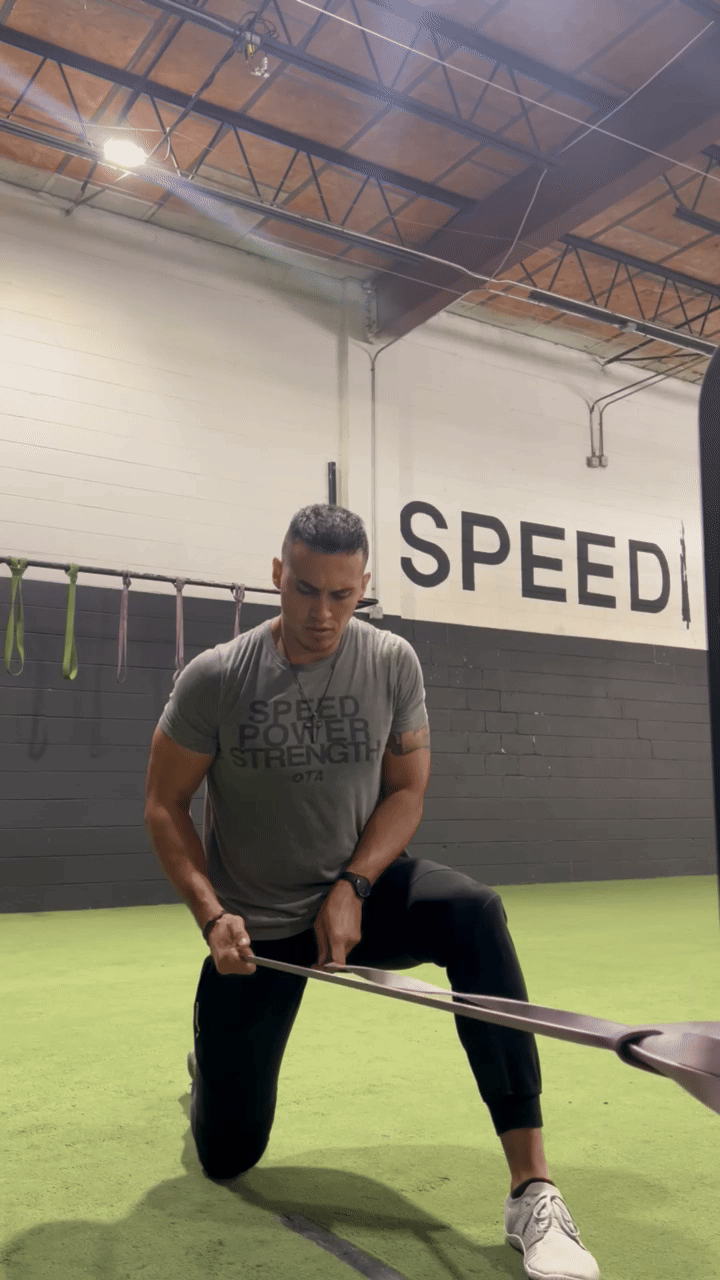 A lot of times, having tight or weak hip flexors contributes to stress on the low back. This is another of my favorite band assisted stretches for the hip flexors. When you set up, place the band at the very top of the hamstring right where it connects to the glute.
A lot of times, having tight or weak hip flexors contributes to stress on the low back. This is another of my favorite band assisted stretches for the hip flexors. When you set up, place the band at the very top of the hamstring right where it connects to the glute.
Kick the back foot out a little bit so that your hip is internal rotated. Make sure as you go into the stretch, you keep your rib cage down so you aren’t arching your low back. To make this more active, squeeze the glute into the stretch.
Lying Open Books (Bodyweight or Band Resisted)
As I said previously, when addressing any areas of pain, you have to look at the overall function above and below the area. The function of the upper spine trickles down and has a direct effect on the lower spine. Your body is a global system, so only focusing on the hips whenever there’s low back issues isn’t always going to be the solution.
If an athlete has bad thoracic spine mobility, that has a direct effect on the lumbar area as well during upper body movements, like overhead pressing. So, this is a simple drill to focus on upper spine rotation and mobility.
Band Resisted Cat-Cows (Lumbar Focus)
 This is a simple progression on the basic cat-cow drill just adding a band to apply more direct resistance on specific areas of your back. You can place the band across along your lumbar spine wherever the pain is located.
This is a simple progression on the basic cat-cow drill just adding a band to apply more direct resistance on specific areas of your back. You can place the band across along your lumbar spine wherever the pain is located.
I’ve used this a few times with athletes who would experience quick relief. You want to perform these very controlled, tuck your pelvis as you flex your spine, and really push as hard as you can into the band.
Suitcase Carrys/Marches
Suitcase carries are a staple exercise in our core training and great for building overall core strength that can help with low back pain and weakness.
The distribution of the weight to one side challenges your trunk stability to maintain a stable spine and more upright torso. Adding the locomotion by walking or marching creates further challenge for your core muscles, especially your obliques and quadratus lumborum (QL), which is a deep abdominal muscle attached to the spine and rib cage, as well as the entire lumbo-pelvic-hip complex, which connects your upper and lower halves.
Think of this exercise as a walking resisted side plank. The athlete has to resist the downward pull of the weight and maintain a tall and upright posture through the entire exercise.
Conclusion
Obviously, these aren’t end all be all solutions. The body is complex and there could be more issues going on. These are simply the easiest drills I’ve commonly gone to that have helped athletes deal with low back issues and continue to train.
Quick disclaimer: if you are suffering from truly debilitating back pain that is really preventing you from moving and training, then you need to see a medical professional. This article is more geared towards athletes who can still train but just have a small low back tweak or nagging pain that’s hindering them. If it’s anything more than that, then see a medical professional to diagnose if something more serious is going on.
Please email me if you have any questions on athletic training at jordon@overtimeathletes.com. If you are interested in online custom coaching, click the link below to apply and join OTA Elite!
If you’re a football player trying to take your performance to the next level this offseason, check out our Football Performance System!
